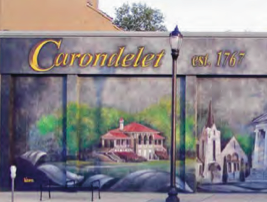Create Public Art Installations or Exhibits
Engage local residents and employ local artists to highlight the unique history and character of a neighborhood
Description

Public art installations and exhibits seek to engage local residents and employ local artists to highlight the unique history and character of a neighborhood while enlivening a public space, advancing social and environmental cohesion in the community, and bringing beauty and pleasure to residents and visitors. Paintings, sculptures, buildings, lighting, music, events, and temporary installations can all contribute to the identity and overall revitalization of a community. Promoting public art or public events for fun, aesthetics, and identity will build the story of a neighborhood in a lasting and influential way.
Related Tools
When paired with other tools, this strategy can make a great impact on the perception, beauty, culture, and revitalization of your neighborhood. Think about great public spaces, better streets, community identity, and the local economy. Try combining Public Art with:
Community Projects
Add your project
Neighborhood Benefits
Environmental
- Highlighted environmental assets or conditions
- Beautified public spaces
- Can showcase aspects of important objects and historic places
Social
- Bolstered community identity and solidarity
- Revitalized spaces with bright and vibrant elements
- Spurred neighborhood-wide revitalization efforts
- Employed, trained, and educated community artists, residents, and youth
- Advertised history and culture of the community
Economic
- Improved, stabilized, and attractive neighborhood streetscapes that boost property values
- Commissions for local artists
- Local artists and impactful projects funded by creative public events
Get Started
1. Reference Use this step-by-step guide: The Public Art Roadmap. It identifies 10 basic steps:
- Form a working group
- Define and plan the project
- Get legal status and insurance
- Raise money
- Find an artist
- Working with the artist
- Permits and agency reviews
- Develop a maintenance plan
- Build the project
- Celebrate
Also see this guide at National Endowment for the Arts.
The Public Art Toolkit spells these steps out in detail:
- Idea Development
- Location Analysis
- Permissions and Permits
- Financing and Funding
- Artist Selection
- Community Engagement
- Fabrication and Installation
- Conservation and Restoration
2. Find a Location For permitting, see the City Public Art Ordinance 68793 and research the following:
- Is the site publicly owned or privately owned?
- Does the site have any special considerations, such as historical status or weak infrastructure?
- Is the project temporary or permanent?
- Who will maintain ownership and maintenance responsibility?
- What are the legal concerns or city permitting procedures?
3. Connect and Fund Work with a local arts center, foundation, artist, or museum to connect your group with artists and funding sources. Some arts organizations in St. Louis are:
- Regional Arts Commission
- Arts and Education Council
- Art St. Louis
- Lemp Neighborhood Arts Center
- Luminary Arts Center
- Pulitzer Foundation for the Arts
- St. Louis Art Museum
- Metro Arts in Transit
- Perennial STL
- Contemporary Art Museum
- COCA STL
- St. Louis Art Works
4. Engage Review the art with the property owner and the community to gain support. Gather feedback at a public meeting, and work with the artist to meet the needs.
5. Install Schedule installation, and if possible, include volunteers from the neighborhood to help with installation or construction tasks.
Information & Inspiration
- Murals on Broadway, St. Louis, MO
- CHOROUS, St. Louis, MO
- Demolition Disneyland, Detroit, MI
- Street Culture Mash, Detroit, MI
- Philly Painting, Philadelphia, PA
- Painted Church, Washington DC
Related Categories
Sustainability Plan Categories
Project Scale
- Park
- Private Site
- Public Building
Download This Tool
Create Public Art Installations or Exhibits doc (392.22 KB pdf)
Need Help Viewing?
You need a program that can open Adobe PDF files. A free option:
- Adobe Reader can read PDF files